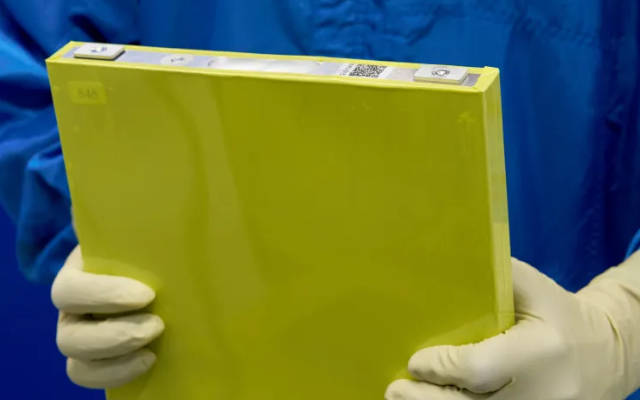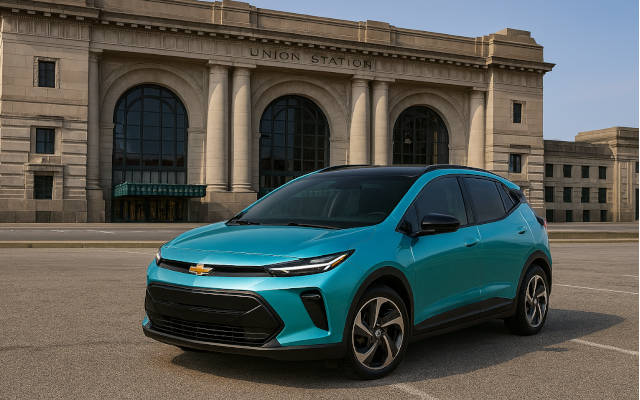 EDITOR'S PICK
EDITOR'S PICK
The Lab Where GM Is Cooking Up New EV Batteries To Beat China
21 Oct 2025 | Synopsis
 GM is developing lithium metal batteries (LMR) at its new EV battery lab to boost range and cut costs. The goal is to surpass current lithium-ion tech by using solid-state designs that offer higher energy density and faster charging. GM aims to integrate LMR into future Ultium-based vehicles, including affordable EVs like the next-gen Bolt. The lab accelerates testing and innovation to meet 2027 production targets.
GM is developing lithium metal batteries (LMR) at its new EV battery lab to boost range and cut costs. The goal is to surpass current lithium-ion tech by using solid-state designs that offer higher energy density and faster charging. GM aims to integrate LMR into future Ultium-based vehicles, including affordable EVs like the next-gen Bolt. The lab accelerates testing and innovation to meet 2027 production targets.GM CEO: Automaker Planning Entire Affordable EV Range
21 Oct 2025 | Synopsis
 GM President Mark Reuss confirmed a new family of affordable Chevrolet EVs launching by 2027, starting with a redesigned Bolt. Built on GM’s Ultium platform, the lineup will offer improved range, lower costs, and broader appeal. Reuss emphasized GM's commitment to mainstream electrification, with multiple models planned to follow the Bolt. The goal: make EVs accessible without sacrificing performance or utility.
GM President Mark Reuss confirmed a new family of affordable Chevrolet EVs launching by 2027, starting with a redesigned Bolt. Built on GM’s Ultium platform, the lineup will offer improved range, lower costs, and broader appeal. Reuss emphasized GM's commitment to mainstream electrification, with multiple models planned to follow the Bolt. The goal: make EVs accessible without sacrificing performance or utility.Norway's Ferry Operator Norled Could Have Saved Money & Staff by Skipping Hydrogen
21 Oct 2025 | Synopsis
 Norway's ferry operator Norled lost €85M after investing in hydrogen ferries like MF Hydra, which cost more to build and operate than battery-electric or diesel alternatives. Hydrogen fuel is expensive, inefficient, and emits more CO2 than expected - double that of diesel and 40x more than electric. Battery ferries like MF Nesvik prove cheaper, cleaner, and more practical. Critics say Norled's hydrogen gamble cost jobs and failed to deliver strategic value.
Norway's ferry operator Norled lost €85M after investing in hydrogen ferries like MF Hydra, which cost more to build and operate than battery-electric or diesel alternatives. Hydrogen fuel is expensive, inefficient, and emits more CO2 than expected - double that of diesel and 40x more than electric. Battery ferries like MF Nesvik prove cheaper, cleaner, and more practical. Critics say Norled's hydrogen gamble cost jobs and failed to deliver strategic value.Archer Beats Out Joby for Lilium eVTOL Patents
20 Oct 2025 | Synopsis
 US-based Archer Aviation acquired 300 patents from bankrupt German eVTOL firm Lilium for $21M, beating Joby, its competitor. The deal includes ducted fan tech, aircraft design, and battery systems. Archer plans to expand beyond air taxis into cargo, defense, and sport aviation. Lilium's collapse reflects broader industry consolidation, as well-funded players absorb assets from struggling startups. Lilium spent more than $1.5 billion developing these technologies.
US-based Archer Aviation acquired 300 patents from bankrupt German eVTOL firm Lilium for $21M, beating Joby, its competitor. The deal includes ducted fan tech, aircraft design, and battery systems. Archer plans to expand beyond air taxis into cargo, defense, and sport aviation. Lilium's collapse reflects broader industry consolidation, as well-funded players absorb assets from struggling startups. Lilium spent more than $1.5 billion developing these technologies.Rebooting the 2027 Chevy Bolt Was More Complex Than You'd Think
20 Oct 2025 | Synopsis
 The 2027 Chevy Bolt retains its familiar look but features a nearly complete electrical overhaul. Built on GM's Global B architecture, it supports OTA updates and advanced driver aids. It uses LFP batteries for ~255 miles of range and 150kW fast charging (10–80% in 26 minutes), plus Tesla's NACS port. Production shifts from Michigan to Kansas, reusing body tooling to cut costs. Target price is under $30K, with deliveries starting January 2027.
The 2027 Chevy Bolt retains its familiar look but features a nearly complete electrical overhaul. Built on GM's Global B architecture, it supports OTA updates and advanced driver aids. It uses LFP batteries for ~255 miles of range and 150kW fast charging (10–80% in 26 minutes), plus Tesla's NACS port. Production shifts from Michigan to Kansas, reusing body tooling to cut costs. Target price is under $30K, with deliveries starting January 2027.
 EVWorld Exclusive
EVWorld Exclusive
Carbon Neutral Summit 2025 Preview - The Hard Questions Automakers Must Answer
01 Nov 2025 |  The EMEA Automotive Carbon Neutral Summit 2025 will confront the gap between ambition and execution. Automakers must scale low‑carbon technologies, decarbonize sprawling supply chains, and secure renewable energy for factories and charging networks. Executives will push for clear policy, carbon pricing, and stable investment signals. Circular economy practices and global competition add urgency. The challenge: make carbon neutrality practical, profitable, and fast enough to meet climate goals.
The EMEA Automotive Carbon Neutral Summit 2025 will confront the gap between ambition and execution. Automakers must scale low‑carbon technologies, decarbonize sprawling supply chains, and secure renewable energy for factories and charging networks. Executives will push for clear policy, carbon pricing, and stable investment signals. Circular economy practices and global competition add urgency. The challenge: make carbon neutrality practical, profitable, and fast enough to meet climate goals.
Can Food Waste Fuel America's Skies? The Promise And Pitfalls Of Trash-To-JetA
01 Nov 2025 |  Scientists are developing ways to turn America's massive food waste stream into sustainable aviation fuel. Using processes like hydrothermal liquefaction, discarded scraps can be converted into biocrude and refined into jet-ready fuel. At full scale, it could replace only a fraction of U.S. daily jet fuel demand, but it would cut landfill methane and diversify supply. Major hurdles remain: costly collection, dispersed feedstock, certification, and economics compared to fossil fuel.
Scientists are developing ways to turn America's massive food waste stream into sustainable aviation fuel. Using processes like hydrothermal liquefaction, discarded scraps can be converted into biocrude and refined into jet-ready fuel. At full scale, it could replace only a fraction of U.S. daily jet fuel demand, but it would cut landfill methane and diversify supply. Major hurdles remain: costly collection, dispersed feedstock, certification, and economics compared to fossil fuel.
Can Coal Power the AI Boom? Wyoming's Bet on a Fading Fuel
01 Nov 2025 |  Wyoming's coal is being promoted as vital for powering the AI boom, but the market reality tells another story. Utilities continue retiring coal plants as cheaper wind, solar, and natural gas dominate. Lease auctions draw little interest, and even China is pairing coal with massive renewable growth. Analysts warn AI demand may be overstated, leaving coal an expensive detour. The conclusion: coal is unlikely to fuel America's AI future.
Wyoming's coal is being promoted as vital for powering the AI boom, but the market reality tells another story. Utilities continue retiring coal plants as cheaper wind, solar, and natural gas dominate. Lease auctions draw little interest, and even China is pairing coal with massive renewable growth. Analysts warn AI demand may be overstated, leaving coal an expensive detour. The conclusion: coal is unlikely to fuel America's AI future.
America's Untapped Power: Why Wave Energy Still Waits For Its Moment
01 Nov 2025 |  America's waves hold vast untapped energy - enough to power over half the nation's electricity needs. Yet wave power lags behind solar and wind. Devices must survive corrosive seas and violent storms, while no single design has emerged as dominant. Developers also face years of regulatory hurdles and high costs that deter investors. New test sites like Oregon's PacWave aim to prove the technology, offering hope that wave energy can finally move from promise to reality.
America's waves hold vast untapped energy - enough to power over half the nation's electricity needs. Yet wave power lags behind solar and wind. Devices must survive corrosive seas and violent storms, while no single design has emerged as dominant. Developers also face years of regulatory hurdles and high costs that deter investors. New test sites like Oregon's PacWave aim to prove the technology, offering hope that wave energy can finally move from promise to reality.
Battle of the Boxes: Tokyo's Compact EV Showdown
30 Oct 2025 |  Three boxy EVs - BYD Racco, Nissan Sakura, and Honda Super-One - dominated the 2025 Tokyo Auto Show, each embracing Japan's kei car tradition with electric innovation. BYD eyes global markets, while Sakura and Super-One remain Japan-focused. U.S. entry would require upgrades in safety, speed, and tech. Their compact charm and urban utility signal a strategic shift in EV design - away from sleek sameness and toward character-driven mobility.
Three boxy EVs - BYD Racco, Nissan Sakura, and Honda Super-One - dominated the 2025 Tokyo Auto Show, each embracing Japan's kei car tradition with electric innovation. BYD eyes global markets, while Sakura and Super-One remain Japan-focused. U.S. entry would require upgrades in safety, speed, and tech. Their compact charm and urban utility signal a strategic shift in EV design - away from sleek sameness and toward character-driven mobility.
 01 Nov 2025 22:41:16 UTC |
RECENT PODCASTS
Tesla RoboTaxis Crash More Than Waymo - 35,000 Rivian Amazon Vans
SEARCH RSSTREAM
 61 New Postings In Past 24 Hours
61 New Postings In Past 24 Hours
Category:energy
Region:NoAmerica
Date:01 Nov 2025
Category:mobility
Region:NoAmerica
Date:01 Nov 2025
Category:energy
Region:NoAmerica
Date:01 Nov 2025
Category:mobility
Region:AsiaPacific
Date:01 Nov 2025
Category:finance
Region:Europe
Date:01 Nov 2025
Category:mobility
Region:NoAmerica
Date:01 Nov 2025
Category:mobility
Region:NoAmerica
Date:01 Nov 2025
Category:review
Region:AsiaPacific
Date:01 Nov 2025
Category:mobility
Region:NoAmerica
Date:01 Nov 2025
Category:mobility
Region:AsiaPacific
Date:01 Nov 2025
Category:policy
Region:NoAmerica
Date:01 Nov 2025
Category:policy
Region:Global
Date:01 Nov 2025
Category:policy
Region:Global
Date:01 Nov 2025
Category:energy
Region:NoAmerica
Date:01 Nov 2025
Category:policy
Region:Europe
Date:01 Nov 2025
Category:policy
Region:AsiaPacific
Date:01 Nov 2025
Category:policy
Region:IndoAsia
Date:01 Nov 2025
Category:mobility
Region:Europe
Date:01 Nov 2025
Category:policy
Region:AsiaPacific
Date:01 Nov 2025
Category:mobility
Region:AsiaPacific
Date:01 Nov 2025